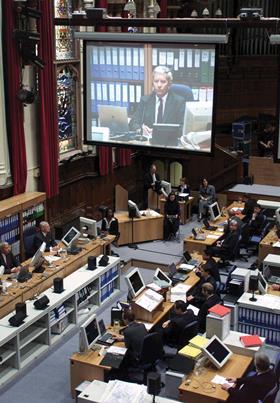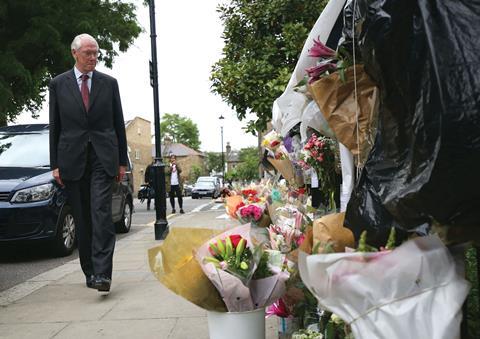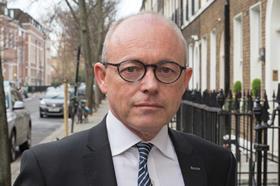Public inquiries have been on the rise in the past three decades, with Hillsborough, Dunblane and Macpherson among high-profile examples. In late-2010, under the coalition government, there were as many as 15 running simultaneously. Currently, eight are ongoing, including into: the Grenfell Tower fire that killed 71 people in June 2017; the contaminated blood scandal that caused the death of about 2,400 during the 1970s and 1980s; and allegations of child sexual abuse in England and Wales.
The increase in public inquiries is linked to a longer-term trend of greater public accountability of government, says Eversheds Sutherland partner Peter Watkin Jones, who leads the firm’s UK inquiries and investigations team: ‘Public inquiries are very valuable tools to get to the truth,’ he says.

But public inquiries are expensive. Since 1990 there have been 68, costing central and devolved governments £638.9m, research by the Institute for Government (IfG) shows.
And that is just the tip of the iceberg, Jones says. He has worked on several, including Grenfell, Independent Jersey Care, Rosemary Nelson, Shipman and Bloody Sunday. ‘Public inquiries are hugely costly. When one sees the cost of the inquiry at X million, that is just the cost of the inquiry running itself,’ he points out. The government department at the centre of concerns that are being investigated typically pays for the chairman, counsel and solicitors to the inquiry, and the cost of legal representation of core participants, which may include the victims and survivors.
But, Jones says, the total cost will actually be much greater: ‘Corporates or public authorities who need to spend substantial amounts of money to resource their involvement in the inquiry do so at their own expense. Those [costs] will never see the light of day because they are from private funding.’
It can be money well spent, of course. Many inquiries have achieved ‘valuable legislative and institutional change’, as well as ‘cultural change’, the IfG says. Lord Cullen’s recommendations in the inquiry into the shooting of 18 people at Dunblane Primary School in March 1996 led to gun control legislation a year later. Sir William Macpherson’s conclusion in his inquiry into the Stephen Lawrence murder – that there was ‘institutional racism’ in the Metropolitan Police, and other police services and institutions across the UK – has had a profound impact on society.
Yet, the thinktank’s overall assessment is that: ‘The formal checks and procedures we have in place to ensure that public inquiries lead to change are inadequate. There is no routine procedure for holding the government to account for promises made in the aftermath of inquiries; the implementation of recommendations is patchy; in some cases repeat incidents have occurred; and there is no system for allowing inquiries to build on the learning of their predecessors.’
Statutory v non-statutory
Many recent high-profile inquiries, including Leveson, Mid Staffordshire NHS Foundation Trust, Undercover Policing and Grenfell, were set up under the Inquiries Act 2005. This was an improvement on its forerunner, the Tribunals of Inquiry (Evidence) Act 1921, in that under the 2005 act the chair has a duty to ‘avoid any unnecessary cost (whether to public funds or to witnesses or others)’. ‘It was perceived, after the Bloody Sunday Inquiry, which lasted a long time and cost a lot of money, as being a gap that needed to be addressed,’ Jones says.
Also known as the Saville Inquiry, after its chair, Lord Saville of Newdigate, the inquiry into the death of 13 civilians killed by British soldiers in Northern Ireland in January 1972 lasted over 12 years and cost £191.5m. It was the last to be held under the 1921 act.
Aside from the issue of costs, there was ‘nothing wrong’ with the 1921 act, Jones asserts. Chairs had greater leeway to run inquiries. If both houses of parliament resolved to inquire into a matter of ‘urgent public importance’ then the tribunal was to have all the powers of the High Court.
By contrast, the 2005 legislation strengthened ministerial control over public inquiries. ‘It was hugely controversial, because there are circumstances under the 2005 act in which the government can effectively pull the carpet from under the chair and bring the inquiry to an end,’ Jones says. Amnesty International called for the act to be repealed. The family of Pat Finucane, the Belfast solicitor killed by loyalist paramilitaries in 1989, said they would not take part in an inquiry under the new legislation because of concerns about its independence.
Under the act, only ministers have the power to set up an inquiry to look at ‘matters of public concern’. They can restrict public access and the disclosure of documents; withhold material from publication in the inquiry report; and terminate the inquiry before publication of the report. The underpinning Inquiry Rules 2006 (IR 2006), which deal with evidential and procedural matters, are a further ‘straitjacket that needs wholesale reform’, Jones says: ‘There is little flexibility under the present rules to allow the chairman to come up with innovative ways of managing their own inquiries, with a view to getting it over the line quicker.’
Although in part designed to reduced costs, the 2005 statutory framework has ended up having the opposite effect.
Take the ‘Maxwellisation’ process (named for the former press tycoon Robert Maxwell). This is set out in rules 13, 14 and 15 of the IR 2006, whereby an inquiry chair must send a warning letter to a person criticised in an interim or final report and give them reasonable opportunity to respond before publication. The process is further complicated by an obligation of confidentiality.
Jones describes the process as ‘nightmarish’, adding several months to an an inquiry. As solicitor to the inquiry into the Mid Staffordshire NHS Trust, that ran between June 2010 and February 2013, he recalls that Maxwellisation took about six months.

It delayed the Iraq Inquiry (Chilcot) by almost two years, from October 2014 to July 2016, according to a 2016 Treasury Committee review of Maxwellisation (which has also been applied to non-statutory inquiries, although it is not a compulsory part of the process).
A 2014 report by the Lords Select Committee on how to improve the 2005 legislation found that the powers given to ministers had not led to the predicted ‘collapse’ in public confidence. But the peers noted that: ‘Even though they have not been used, the existence of these powers causes us concern, simply because the potential for abuse may lessen public confidence in the inquiry process.’ They made 33 recommendations to ensure ‘stronger controls’ on these powers, including: revoking the rules requiring the Maxwellisation process; abrogating the power of ministers to issue notices restricting public access to an inquiry and to withhold material from disclosure or publication, except when national security is at stake; and requiring the chair’s consent for the termination of a panel member’s appointment. The government rejected these and many other recommendations in the report.
Matthew Hill, a barrister at 1 Crown Office Row, London, says the current legislation and rules ‘bring a certain formality to a public inquiry, making it a semi-judicial process, but if you don’t want that, you can have a non-statutory inquiry’. In fact, Hill observes: ‘The vast majority of inquiries in this country are done on a non-statutory basis.’
There are four types of non-statutory public inquiry, a Commons briefing paper relates: non-statutory ad-hoc inquiries, including independent panels; committees of privy counsellors; royal commissions; and departmental inquiries.
Examples of non-statutory ad hoc inquiries include the Detainee Inquiry, the Hutton Inquiry (death of Dr David Kelly), the Butler Inquiry (relating to weapons of mass destruction) and the Morecambe Bay Inquiry. ‘The downside is that a non-statutory inquiry doesn’t have the powers of the 2005 act, and in particular it can’t compel witnesses to attend,’ Hill says.
‘There is a tendency always to say, we need a judge-led inquiry into X,’ adds Hill, who worked on the Hillsborough inquests and the Birmingham pub bombings. ‘Public inquiries are powerful sledgehammers to try and address problems, but you first have to decide what the problem is that you are trying to address and whether or not the public inquiry is actually a useful tool to address that.

‘They are not the only answer that is possible on the available evidence.’ Inquests, for example, can sometimes be a cheaper and quicker way of achieving outcomes. It was the Hillsborough inquests – and not the judicial inquiry (led by Lord Justice Taylor) – that in 2016 concluded that 96 football fans who died in the 1989 disaster were unlawfully killed.
Narrow focus?
Moreover, some public inquiries have too broad a remit. ‘Recently, there has been a tendency to have very large public inquiries into thematic events, such as the culture and ethics of the press [Leveson] or looking at the way undercover policing has been done for 50-odd years,’ Hill says.
‘It is much harder for a public inquiry to look at more nebulous concepts such as the culture and ethics of the press, because you are not quite sure what it is that they are investigating, and the recommendations that can be made as a result are far more political and ethereal,’ he adds.
‘These are very broad questions. I think public inquiries have been more effective in addressing a specific incident.’
Frederick Way, negotiation consultant and manager at the CEDR Foundation, points to the Fingerprint Inquiry. This ‘came in on budget because the issue was actually quite limited and factual’. It inquired into the forensic procedures used to verify fingerprint evidence associated with HM Advocates v McKie in 1999. Way provides another example: ‘In the Mid Staffordshire Inquiry, although there were a lot of recommendations and it was a complicated review, the terms of reference were quite clear and that normally helps.’ It investigated the circumstances that led to serious failings in standard of care at Mid Staffordshire Hospital between 2005 and 2009 .

Yet, as Red Lion Chambers barrister Sailesh Mehta observes: ‘If the terms of reference of the inquiry are too narrow, then in my view a public inquiry becomes partly or wholly unfit for purpose.’ A case in point is Grenfell. Mehta argues that the terms of reference of the inquiry should have been ‘much wider’ to examine not just the immediate causes of the tragedy, but other issues such as government cuts to council funding and why high-rise buildings are more likely to be occupied by immigrants. ‘It depends on what part of the political and social divide you are in. If you are a minister, or the prime minister in this case, you want to make sure that the terms of reference are narrow enough to make no wider criticism of you or your government, but wide enough to assuage public anger.’
The inquiry, ordered by Theresa May and chaired by retired Court of Appeal judge Sir Martin Moore-Bick, has also been criticised for excluding social housing from its remit.
In December, the Equality and Human Rights Commission launched its own review into the fire to investigate whether the Royal Borough of Kensington and Chelsea, which owned Grenfell Tower, failed in its duty to protect life and provide safe housing.
Terms of reference define the scope of an inquiry’s remit, but they ‘might be seen to be driven by narrow political agendas’, according to guidance published by CEDR for chairs and commissioning bodies of public inquiries that Way co-authored. The conflict management and resolution consultancy recommends a one-month ‘draft terms of reference’ system to allow witnesses and other interested parties, including the public, to comment and suggest amendments.
Ad hoc process
CEDR also suggests the use of alternative dispute resolution techniques such as mediation and dialogue facilitation, moving away from the ‘litigation’ or ‘mock trial’ model that is often used in public inquiries. This will cut costs. For example, more than half of total spend in the Bloody Sunday Inquiry went on lawyers.
Some 44 of the 68 public inquiries run between 1990 and 2017 have had judicial chairs, for reasons including political independence and experience of running hearings. Yet ‘approaching inquiries like court cases can constrain change’, the IfG said. Non-judicial chairs have shown more willingness than judges to stay involved beyond the inquiry’s completion to ensure recommendations are implemented by government. Baron Laming, a former social worker who led the inquiry into the death of Victoria Climbié and the Review of Child Protection, drew up detailed plans to implement the recommendations; while Lord Bichard, the civil servant who chaired the Soham Murders Inquiry, informally reassembled the inquiry six months after the report to monitor progress.
A further worry is that ‘the current system for selecting and appointing chairs is nearly as ad hoc as the process of establishing inquiries themselves’, the IfG noted. An agreed process and greater transparency could save costs and enhance public confidence. The choice of inquiry chair is often contentious, as shown by the inquiry into historical child sexual abuse (Professor Alexis Jay is the fourth head after three previous chairs resigned), and Grenfell.
The process is a ‘mystery’, Jones asserts. ‘Unless you are a court judge nobody knows how somebody gets appointed, not even the [appointees] themselves.’ The only statutory requirement is for appointing judges, whereby the relevant minister must consult with the lord chief justice or another relevant senior member of the judiciary.
In his oral evidence to the Lords Select Committee, Robert Francis QC said: ‘Like most chairmen, I had the experience of being phoned up out of the blue and asked to decide within an hour whether I would like to chair the inquiry because the minister was in a hurry to make an announcement.’
There have been repeated calls to establish a dedicated inquiry unit either within HM Courts & Tribunals Service, as suggested by the Lords committee, or within the Cabinet Office, as recommended by IfG. CEDR, too, advocates the creation of an ‘independent inquiries office’. Such a unit or office would have a variety of functions – from centrally administering inquiries and providing much-needed guidance for inquiry members and staff, to acting as a ‘repository’ for information about previous efforts and liaising with the media. A dedicated inquiries unit ‘should result in major savings’, the Lords committee posited.
It found that the advice for inquiry chairs, contained in the 50-page Cabinet Office Guidance on inquiries, is ‘brief and only in the most general terms’. Every inquiry secretary is responsible for writing and submitting a ‘lessons learned’ paper to the Cabinet Office and the sponsor department within two months of the completion of the inquiry; yet the Cabinet Office held only one such paper for inquiries under the 2005 statute (the Baha Mousa Inquiry), the peers discovered.
‘We do enough of them as a country that there is a role for a unit within government,’ Way says. ‘Every public inquiry reinvents the wheel when they could be learning from previous inquiries better.’

Lawyers are in favour of centralising and standardising the process, or at least parts of it. Anne Studd QC of 5 Essex Court, who has represented the MPS in the Azelle Rodney Inquiry, and is involved in the child sexual abuse inquiry on behalf of two police forces, says: ‘There are absolutely merits so far as the back office is concerned.’ This includes setting up a costs protocol, selecting disclosure software, and all the requirements for the running of an office – all of which takes time: ‘There is merit in having a team of people who have done that before.’ The team could include civil servants from the MoJ and from the sponsor department.
Asked how likely it was that the government would set up a dedicated inquiries unit, Studd replied: ‘The government are so against giving any indication that public inquiries are here to stay, or are a way forward because of the expense. So if it does happen, it will happen quietly.’
Recommendations
Inquiries can only make recommendations, which are non-binding; and it is up to central or devolved governments to decide whether or not to implement them.
Thanks to the Mid Staffordshire Inquiry, there is now a ‘duty of candour’ in the NHS, while the Bichard Inquiry into child protection led the then Labour government to launch a vetting and barring scheme in 2009 that protects children and vulnerable adults by preventing those who pose a known risk of harm from working with them.
But many proposed changes have not happened. That includes reform recommended in 2005 by Dame Janet Smith, who led the Shipman Inquiry, that independent medical examiners should scrutinise death certificates. The conclusions of the Macpherson Inquiry were ‘excellent’, Mehta observes, but he adds: ‘It is what happened after the inquiry that some people questioned because there should have been a yearly audit carried out by parliament to make sure that the conclusions were implemented.’
Only six inquiries (out of 68) have received ‘a full follow-up by a select committee to ensure that government has acted’, the IfG said. ‘Parliament can and should play a more significant role in holding ministers to account’ and the ‘Liaison Committee should consider adding an 11th core task to the guidance that steers select committee work: scrutinising the implementation of inquiry findings,’ the thinktank recommended.
But when measuring the effectiveness of public inquiries, there are other metrics.
Take former prime minister David Cameron’s state apology in 2010, following the publication of Lord Saville’s report, for the ‘unjustified and unjustifiable’ killing of 13 civil rights marchers by the British Army on Bloody Sunday in Derry 38 years before. ‘The inquiry completely and utterly exonerated those who were killed,’ says Barra McGrory, who worked on the inquiry. ‘And that gave enormous relief to the families of those individuals who lived under the shadow of accusation that their loved ones who were killed were IRA gunmen.’
State misconduct under scrutiny

Barra McGrory QC (pictured) former DPP for Northern Ireland, was in the thick of the Bloody Sunday, Rosemary Nelson and Robert Hamill inquiries established as part of the Northern Ireland peace process to investigate allegations of state misconduct during the Troubles. Hamill, in which McGrory appeared as QC for the family, converted half way through to an inquiry under the 2005 act.
‘I find the difference [between the 1921 and 2005 act] to be minimal in terms of the ability of the inquiry to get to the heart of the matter,’ says McGrory, now an associate tenant at Doughty Street Chambers. But he adds: ‘The key controversial difference is the role of the minister in respect of the power to withhold the material. In Bloody Sunday, we had the significant benefit of the 1921 act. The inquiry got everything. Lord Saville became the adjudicator of whether or not that material was admitted or disseminated among the parties, but he saw everything. ’
He adds: ‘Most public inquiries are examining alleged state misconduct in the first place. So what the 2005 act does is give the state a degree of control that many people think it shouldn’t have. It is not complete control because the exercise of that control is subject to judicial review. Nevertheless it is a dilution of the far-reaching powers that were introduced in 1921.’
A first inquiry, led by Lord Widgery, reporting 11 weeks after the events of 30 January 1972, was described by many as a whitewash. It exonerated the British Army in that the soldiers had only returned fire, claiming that there was ‘strong suspicion’ that some of those shot ‘had been firing weapons or handling bombs’.
Furthermore, Bloody Sunday had ‘a significant effect in that it created a vast body of material upon which the issue of criminal liability could be revisited in a much more thorough and open way,’ McGrory adds. ‘It triggered a police inquiry, which has resulted in a report sent to the DPP and there will be decisions issuing shortly on criminal proceedings.’
Crusading media and public

The media and the public have promoted inquiries and are seen as guarantors of their independence, but some argue they also interfere.
‘The media clearly have an effect upon the lead-up to the inquiry and also the terms, or justifying the terms [of reference],’ says Red Lion Chambers barrister Sailesh Mehta (pictured). He observes how Sir Martin Moore-Bick was ‘pressurised’ by media reports to visit, and engage in ‘small talk’ with residents critical of his establishment background.
‘For a public inquiry to be effective it needs to be independent’ and that includes from ‘deliberate meddling by politicians or pressure or agitation by press and campaigners’, according to Matthew Hill, a barrister at 1 Crown Office Row, London. Yet to be credible, a public inquiry also has to ‘earn respect’. ‘There was a great deal of public scepticism about the findings of the Hutton Inquiry [into the death of Dr David Kelly],’ Hill says. ‘That reflects the change in approach in society. There used to be a greater deference to judges.’ Lord Hutton’s report ‘was described as a whitewash, and he personally was vilified’, the Lords committee said.
But more often than not, it is thanks to the press and campaigning groups that public inquiries are set up in the first place. ‘Unless there are crusading people out there to mobilise the press and generate a public view that an inquiry should be had then it is very unlikely there would be one,’ Jones says.
Some still argue that triggering public inquiries should be more straightforward. ‘I wish it was easier to institute inquiries,’ Mehta says. ‘I wish there was an application in law you could make, rather than build up a head of steam with public pressure and the press.’
Although an inquiry does not award damages and compensation, Studd observes: ‘It doesn’t stop you from suing anybody. But you can do that at the end of the public inquiry. Where, for example, there has been criticism sufficient to bring a claim in negligence the defendant isn’t going to resist it after there has been a report.’ Proceedings are issued before the public inquiry and then they are stayed pending the outcome of the inquiry. Studd, who is acting for the Mayor of London in Grenfell, says: ‘Let’s say, for example, if the cladding is at fault in Grenfell Tower – it is very unlikely that the cladders wouldn’t pay out to the victims.’
The time it takes to publish the report of an inquiry, two and a half years on average, is a further issue that can be relatively easily mitigated. According to the IfG, the risk of this extended wait after the incident that is the subject of the report is that similar incidents may recur and recommendations may by superseded by events. The IfG recommends publishing interim reports ‘as rapidly as possible’. CEDR has proposed a ‘first pass model’, whereby once 20% of the time that an average inquiry should take has passed, the chair completes an interim report.
There is clearly no shortage of ways public inquiries can become more effective and less burdensome for the public purse. But lawyers are in no doubt of their value: ‘It is the ultimate measure of accountability to have a public inquiry,’ says McGrory (see box). ‘It may or may not be complete or perfect, but when it comes to the question of serious public concern over alleged serious state wrongdoing, it can be very effective.’
Marialuisa Taddia is a freelance journalist



























No comments yet